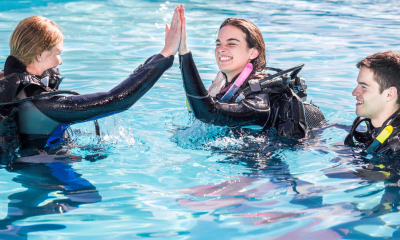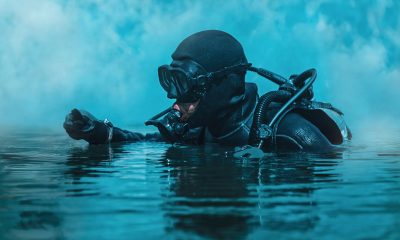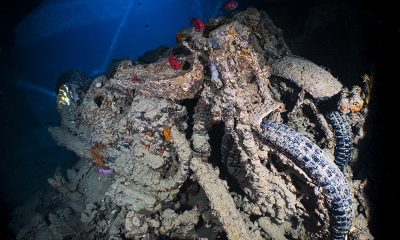Travel Stories
JOURNEY TO THE LIGHTHOUSE REEF
My name is Carole, I have been diving for 18 years and I’ve been a PADI Instructor for 17 of them. Today I am the Technical Manager at Fantasea Divers, responsible for overseeing the dive operation and working with Chris Harding, who together with Ema Louis is a partner at Coral Hotel & Fantasea Dive Center, located 90km North of Sharm el Sheikh.
Like me, when asked what inspired them to start diving, many divers of my generation relate their thirst for the underwater realm to that of the legendary Jacques Cousteau, who in his time was a trailblazer and conservationist for the underwater world and its inhabitants.
When the time was right and an opportunity arose to realize one of my dreams, I learnt to dive. Little did I know, way back then, it was just the start of the journey I was to undertake after completing the PADI Open Water Course with James & Mac at Barracuda Dive Centre in Hurghada.
That said I was absolutely not prepared for the tedious & boring hours of theory we had to sit through in the classroom. I really wondered what the hell I was doing when out of the window all I could see were other tourists around the pool enjoying themselves knocking back the Stella……… but when the time came & we were jumping off a boat into the clear blue waters of the Red Sea I was instantly hooked – I loved it and could definitely see myself living this life.
In fact on my return home I joined a dive club called Dive Force Marine and started working my way through the PADI courses up to Instructor. I experienced the delights of the popular UK training sites such as Stoney Cove, Swanage & Gildenburgh to name but a few. Every opportunity I got was spent under water. Within the year I was on my way to Malta with a bunch of other wannabe Instructors under the tutelage of PADI Course Director Gary Mawson and his entourage of IDC Staff.
Soon after I successfully passed the IDC IE, the company I was working for was relocating and I was given two options – I could continue with the rat race, or alternatively accept voluntary redundancy and a wad of cash; a no-brainer really! My dream was coming true and without hesitation I took the wad, tied up loose ends and flew back to Egypt, a place that has felt like home like no other.
I arrived in Dahab in March 1994 quite by chance. I originally went back to Hurghada to look for work, but it was their winter season and most places were fully staffed and wanted German speaking Instructors. Having spent a couple of years in Germany with the army I only knew the most important phrases that mattered to me, ‘zwei bier bitte’, ‘ein kaffee bitte’ & my all time favorite used at Macdonalds in Paderborn, ‘keine zwiebel bitte’ – none of which was really going to get me far!
One evening, after consuming a large amount of the local brew in Peanuts bar in Hurghada, a plan was hatched to go to Sharm el Sheikh to look for work. Everything looks doable after a few bottles of the local brew! However the boat trip from Hurghada to Sharm the next day was not something I had prepared myself for.
The stomach-churning journey seemed to go on forever and the sea conditions only added to my discomfort. I was secretly thinking we are all going to die and at some point had wanted to. It was hellish with no shade, no loo & no refreshments. I had not given any thought to bringing water with me to offset the dehydration effects caused by the previous evening’s happy hour and I certainly wasn’t happy at that moment in time. Lesson’s 1 & 2 learned there and then! On arrival to Sharm I had had enough of it immediately and was talked into a taxi headed for some place called Dahab.
On arrival I honestly thought my new friends had stitched me up. I was shocked at the basic surroundings, unfamiliar food (turned out to be the best diet ever), funny smelling smoke that wafted out of the beach restaurants (I use the term ‘restaurants’ loosely there) and the communal feel of Dahab. I spent the first week sleeping in my wooly bear as the camp rooms did not provide any bedding and I didn’t know that Egypt like anywhere else, as it turns out, was really rather cold in the winter (I’m ex-army & a city girl at heart and had never travelled that far out of my comfort zone in those days – and yes, I roughed it whilst in the army on occasion, but at least they fed you & gave you a blanket and a pillow).
I got over my initial thought process of “What the bloody hell am I doing here” and knew I had to make the best of it. I had sold my home, most of my worldly possessions & against the advice of my family & friends said goodbye to everything that was familiar to me, so I got on with it and set about looking for work.
Dahab back then was a small fishing village populated mainly by the Bedouin and had only 8 Dive Centers, and it was a backpacker haven. The attraction for divers of course was not what was on the surface (stoneheads & hippies may beg to differ), but what awaited you underwater.
Even though I was a new Instructor, I had worked hard to become an experienced diver, so after a short interview I made my teaching debut at Adventure Dive Club, uniquely run by three Egyptian sisters who had a passion for diving & business. This Dive Center was situated next door to the well established Fantasea Divers, owned by my now good friend Chris Harding, it was there I met Ema who was working on the Dive Counter at the time and who was to become a lifelong friend. Both Dive Centers were located conveniently in front of the Lighthouse Reef, in a time when there was no restriction on how close the buildings could be to the sea.
When it came down to it camp life did not suit me at all and as luck would have it a couple of Instructors from Fantasea were leaving and I ended up renting their house on the beach within a compound owned by a Dutch Instructor, who at the time was the Manager at Fantasea Divers. Life was looking good.
For the next nine months the Lighthouse became my home and I got to know it extremely well. I taught so many Open Water & Advanced Courses back to back, mainly to backpackers of all nationalities. South Africans, Aussies & Kiwis were a dream to teach; they were born to be in the water. Spending so much time at the Lighthouse working gave me the passion to want to dive and explore all the other dive sites in Dahab during my precious leisure time.
So let me tell you about my beloved Lighthouse Reef. Firstly it is called the Lighthouse because during the Israeli occupation there was an actual Lighthouse structure there; after they left it was re-located further up the beach, and if you know where to look you can just about see the top of it as it reaches above the date palms that now surround it.
The Lighthouse Reef is as diverse as it is beautiful, as it offers many shallow & deep dives both to the North & South. Even though Dahab is renowned for its wind, one can dive at the Lighthouse reef at almost any time of the year, day or night, because of its sheltered position.
The Lighthouse dive site is suitable for beginners, experienced & more recently Technical Divers alike. The easy entry & exit hosts a gentle sloping bottom that leads to a subtle drop off. The first shelf is perfect for confined water and other training dives. Around the inner reef heading North you will find large coral pinnacles that loom from the sandy bottom @ 10m – 18m absolutely teaming with marine life. As one travels along the reef, large bright green cabbage corals can be seen sprouting from the seabed. An overhang juts out, which houses a bright a red sponge and a delicate fan coral, which is an absolute favourite hangout for Crocodile Fish & Blue Spotted Rays. Passing this, there are a couple of dead pinnacles to the left & right, leading to a saddle, which is best crossed at 16m. This area is rich in flora and fauna and looking carefully stone & scorpion fish can be identified blending in with their surroundings, ready to pounce on their prey. Napoleon fish and a Turtle can also sometimes be seen here. If there is a current present it feels like you’re flying over the saddle; coming back however requires some effort and good buoyancy control.
The deep dive to 30m is usually made on the outer East facing reef. By following the sloping bottom to the outer reef there is a sprawling mass of large coral pinnacles rich in marine life. One of the pinnacles has a little cave in it that you can easily sit in and watch the blue for passing Pelagic, including Mantas & Eagle Rays. Some people get a bit twitchy at the mention of sharks! Swim further on and you come to the bottom of the saddle where at 27m a large gorgonian fan coral can be found, however due to a very bad storm a few years ago it fell over. Efforts were made to re-position it. It is still there but no longer upright & majestic as it should be.
The Southern dives, deep or shallow, offer some of the most fascinating sightings of marine life you can imagine. These dives offer the same gentle sloping descent. There are a mass of manmade terracotta pots that have been sunk at 16m to deliberately add interest to the vast sandy bottom, which encourage coral to grow & marine life such as moray eels & octopus to inhabit. The sea grass that is prevalent in that area has recently seen a sea horse population boom, and it is not unusual to see turtles grazing there, or ghost pipe fish milling around. At 9m just past the confined area there used to be the remnants of an old jeep, encrusted with coral which was a haven for lion & stonefish, although sadly over the years this little gem has all but disintegrated, and only the chassis remains.
At 12m there is training area complete with varying sizes of triangles to help perfect buoyancy control. Further along you come to Banner Fish Bay, so named because of the masses of the like-named fish that hang there above the small coral blocks. Swimming at a right angle from this spot to about 30m you can find a large sandy ridge running East; this ridge was caused by a huge storm when its waters rushed down from the mountains and swept a few shops and a dive center into the sea. One of the shop’s that was swept away was a jewelers and legend has it that it’s gold lies there somewhere. Many years ago I was blessed to see two guitar sharks resting on the bottom there.
After leaving Adventure Dive Club it was time to dive with the big boys at Nesima, then a 5 Star IDC Center, where I would put my knowledge & experience of the Lighthouse and other dive sites around Dahab to good use and make new friends for life.
Today Dahab has changed enormously from when I first arrived here. There are now over 50 Dive Centers along the coastline of Dahab. The Bedouin & Egyptian now work side by side, and there are good restaurants offering everything from Italian to Sushi. The infrastructure built over the last ten years provides a more comfortable lifestyle. There are still a few camps left and back packers still come, but not in the numbers that they used to. These days most tourists prefer a package holiday as more and more families are venturing here & taking the plunge at the Lighthouse.
Don’t just dream it, Do it! Has always been my mantra. The risks one takes to achieve the dreams held dear can pay off if you can take the rough with the smooth, and don’t get bent out of shape should the internet go down for more than an hour! There’s always the Lighthouse Reef.
The Lighthouse Reef holds many good memories for me and to this day I still love to dive there, given any opportunity.
Blogs
Alonissos: The complete diving destination (Part 1)

In June we were incredibly fortunate to be invited to dive in Alonissos, a small Greek Island in the Sporades island chain located in the North Aegean Sea. While I have long been a big fan of the Greek Islands as a great holiday destination, I had not had the opportunity to do any diving on previous visits and Mike and I were extremely excited to see what Alonissos had to offer both above and below the surface!

The Sporades are easily accessible via the airport in Skiathos (the first island in the chain), which is served by Jet2 flights from all major UK airports from May through October. Numerous ferries and charter boats make island hopping from Skiathos Town a breeze. After an hour boat ride, the picturesque port of Patitiri was a wonderful introduction to Alonissos, where we were met by our gracious hosts Kostas of Albedo Travel and Dias of Alonissos Triton Dive Center. Mike and I were delighted to be staying at the Paradise Hotel, aptly named for its stunning views over the sea and great location for walking to the waterfront.

Alonissos is beautifully situated in the National Marine Park of Alonissos and the Northern Sporades, the largest marine protected area in Europe. The surrounding seas offer fabulous marine life, including incredibly rare species such as the Mediterranean monk seal. They boast deep walls covered in gorgonians and sponges, stunning topography with caverns, swimthroughs and pinnacles, and the first accessible ancient shipwreck from 500BC!

In locations where historical sites have been reported, the waters are largely restricted, but with collaboration between government, underwater archeologists and dive centres, incredible underwater museums are being created for a truly unique diving experience. Alonissos is home to the first of these, the Ancient Shipwreck of Peristera Accessible Underwater Archeological Site. The chance to dive into history (along with reports of healthy reef life and amazing underwater topography) meant Mike and I were keen to get in the water.

Our introduction to the diving around Alonissos was at the Agios Georgios Pinnacles, in the channel between Alonissos and Skopelos. This fantastic site was named “The Chimney,’ and proved to have a huge amount to see. We got to a decent depth here (over 25m), and marvelled at a colourful reef wall with a wonderful swim through whose rocky walls were absolutely covered with life. As well as brilliant topography there was no shortage of macro life here. We saw numerous nudibranchs, five different species in total. The second dive at Mourtias reef nearby was a shallower dive along a nice wall with lots of crevices. Several moray eels and grouper called this site home. We enjoyed looking in the crevices for lobster and smaller benthic life, such as cup corals and tunicates.

Our itinerary allowed us two dives a day with afternoons left to explore the island with our hire car and evenings to enjoy the famous Greek hospitality. This proved to be a lovely mix of in-water and land based diversions.

The next days diving to the Gorgonian Gardens and Triton’s Cave was to be even better! These two stunning sites are nothing short of fabulous. The Gorgonian Gardens was a deep wall near to the Agios Georgios islands. The ever-present currents in this deep channel meant that the sea life was amazing … the namesake Gorgonian sea fans dotted the wall at a depth of 30 to 50 meters, getting ever larger the deeper we went. Above 30m was by no means less beautiful, with sponges, corals, scorpionfish, moray eels and some rare and colourful nudibranchs.

The second shallower dive of the day was to Triton’s Cave or the Cavern of Skopelos, on the east side of that island. The spectacular rock formations had wild striations both above and below the water making a truly epic topography. The cavern entrance was at 14m, and big enough for a buddy pair, winding up to 6m and passing two beautiful windows out into the blue. Emerging from the cavern, the light at the shallower depths and the incredible rock formations made for a fantastic gentle swimming safety stop and we all surfaced by the boat with massive grins.

Check out our next blog :Alonissos: The complete diving destination (Part 2)” to hear about our amazing dive on the 2500 year old Peristera Wreck!
Thanks to:
Alonissos Triton Dive Center https://bestdivingingreece.com/
Albedo Travel https://alonissosholidays.com/activities/
Paradise Hotel https://paradise-hotel.gr/
Alonissos Municipality https://alonissos.gr/en/
Blogs
Mamma Mia! Diving Skopelos (Part 2)

Our second days dive itinerary was to the famous Christoforos wreck! This is arguably the best dive in Skopelos and though only open to divers with deep diving experience, this 83m long wreck is well worth the visit.
The Christoforos sits in 43 meters of water with the deck at 32 to 35 meters. A 30m dive can give an impressive view of the wreck, though such a large wreck needs a few dives to truly do it justice. Given its ideal location just a 2 minute boat ride from the dive centre dock it is an excellent first dive of the day. The sheltered site is also diveable in all but the absolute worst weather so although deep, the water is usually clear with little to no current making it a very pleasant dive. The site is superb for technical diving and a great training site for the Tec 40 and 45 programs, offered by Skopelos Dive Center.

The Christoforos wreck was originally a collier ship built in 1950 at Grangemouth shipyard under the name “Thomas Hardie”. In 1976 she joined the Greek merchant fleet as “Christoforos”. On the 2nd of October 1983 the Christoforos was carrying 2600 tonnes of cement from Volos to Piraeus Port. During the voyage the weather turned, resulting in the ship developing a 7 degree list, whereby she changed course for safe anchorage at Panormos, Skopelos. The ship reached Panormos at 16:00 with a list of 17 degrees and water ingress to No. 1 hull. Though attempts were made to right the vessel, the crew were ordered to abandon ship at 22:00. The captain, lieutenant and the quartermaster remained to try and save the ship, but had to abandon the attempt themselves and the Christoforos finally sank at 05:30 on 3rd October 1983. She now sits upright in 43 meters of water less than 200m from shore in Panormos.

Diving has only been allowed here since 2018, so the wreck is very well preserved and a real treat to dive. Permission to dive here was granted by the authorities after lots of incredibly hard work by the Skopelos Dive Center staff. Having a fantastic wreck in such an amazing location and in excellent condition is a real privilege.

Of all the sites in Skopelos this was the site Mike and I were most keen to experience. Having kitted up and zipped across the bay to the mooring, we left the surface and followed the descent line until the wreck emerged spectacularly from the blue at 15m. She is a big and beautiful wreck, sitting as though calmly continuing her journey along the seabed. With most of her original features still intact there were points of interest everywhere, including the anchors, winches, ships telegraphs, the wheel and RDF antenna.

We found that aquatic life had colonised the ship, with schools of fish, electric blue nudibranchs, a large moray eel and the resident scorpionfish lurking inside the bridge. The Christoforos was truly a stunning wreck and despite maximising our time at depth we eventually had to say our goodbyes and begin the slow and steady return to the surface.

After a superb morning dive we had the afternoon to do a little sightseeing of the island, with a trip to the church of Agios Ioannis Kastri made famous by the blockbuster movie “Mamma Mia!”. Mike and I spent a happy afternoon pootling around in our little hire car before meeting up with Lina from Skopelos Dive Center. An underwater archeologist as well as a dive professional, Lina had offered to show us a rather special attraction, the Christoforos shipwreck Digital Spot public information and awareness centre.

A fantastic initiative made possible from the collaboration of the government and hard work of the staff at Skopelos Dive Center is the “Digital Spot” in Agnontas port. This information center has a number of displays on the history of the Christoforos wreck, the process by which the wreck was allowed to be opened to the public for diving tourism, other sites of historical interest in the area, a video of the wreck and the best bit, a virtual reality dry dive experience! The beauty of the VR system is that non diving members of the family can see what you have seen on the wreck, or you can see areas that you may not have explored during the dive due to time or depth limitations. It was a truly immersive experience and a great addition to the dive itself.

After a wonderful day we celebrated our last evening on the island with an exquisite meal in Skopelos Town with fabulous views over the town and bay, washed down with the excellent local wine. The lamb with lemon and potatoes was a meal which I could happily eat every day for the rest of my life!

Skopelos is an island that truly has it all. The diving is excellent, the landscape is beautiful with plenty of non diving activities, the locals friendly and the food and drink superb. Given how accessible it is as a holiday destination it has avoided becoming overcrowded and even in peak season offers a fun yet relaxing atmosphere. We highly recommend giving Skopelos a visit. We will certainly be back again!
Thanks to:
Municipality of Skopelos (https://skopelos.com/)
Skopelos Dive Center (https://sporadesdiving.gr/)
Ionia Hotel (https://www.ioniahotel.gr/en)
Dolphin of Skopelos (https://dolphinofskopelos.com/)
Ta Kymata restaurant (@takymata)
The Muses restaurant (https://www.facebook.com/TheMussesMousses/)
Aktaiov resturant (https://skopelos.com/listings/aktaion-taverna/)
-

 Blogs2 months ago
Blogs2 months agoDiving With… Nico, Ocean Earth Travels, Indonesia
-

 News1 month ago
News1 month agoMurex Bangka Announce New Oceanfront Cottages & Beachfront Dining
-

 Blogs2 months ago
Blogs2 months agoA new idea in freediving from RAID
-

 Marine Life & Conservation1 month ago
Marine Life & Conservation1 month agoIceland issue millionaire whale hunter a licence to murder 128 vulnerable fin whales
-

 Marine Life & Conservation2 months ago
Marine Life & Conservation2 months agoThe Shark Trust Great Shark Snapshot is back
-

 News3 months ago
News3 months agoCharting New Waters; NovoScuba Goes Global with the Launch of their Revolutionary Dive Training Agency!
-

 Gear News1 month ago
Gear News1 month agoNew Suunto Ocean – a dive computer and GPS sports watch in one for adventures below and above the surface
-

 Marine Life & Conservation Blogs2 months ago
Marine Life & Conservation Blogs2 months agoBook Review: Plankton















